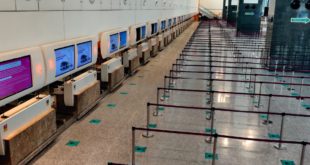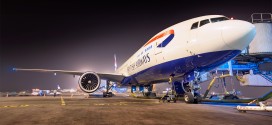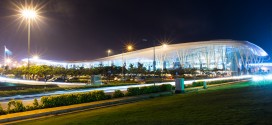The new Bengaluru International Airport (BIA) will be opened on May 11, 2008.
The Election Commission may not have permitted any festivities and gala celebrations, but then, we Bangaloreans, are more interested in the long overdue additional capacity of the new airport.
Various government agencies are busy upgrading or creating roads, to improve access to the airport for the expected 25,000 vehicles per day, to and from the airport. The road from Vidhana Soudha till BIA is being widened and being made “signal free”. The National Highway NH-7 from Hebbal flyover onwards till BIA, will be 8 lanes (6 on the highway, and 2 access roads). All of us, expect vehicles to “fly” on the highway and cover the distance to the new airport in under 20 minutes.
In our rush to ensure quick access to the airport, we have overlooked the pedestrians who need to cross the NH-7 highway, and their safety.
There are people on both sides of the NH-7 highway from Hebbal flyover till beyond Yelahanka, be it in housing colonies, factories, hospitals, schools, or malls. The National Highway Authority of India (NHAI) who is responsible for NH-7, has not provided any form of over-bridges or under-passes.
Those of us who use NH-7 currently, have seen people literally scampering across the highway, in fear of their lives. It is risky, not just for the pedestrians, but also the vehicles, especially two wheelers.
If we do not address this issue soon, I fear it is just a matter of time till serious accidents become the norm.
It is still not too late. The BBMP has designs for ready made Skywalks, which can be erected in less than a month. Advertisers will be happy to pay the Rs. 1.5 to Rs. 2 Crore each Skywalk costs, in return for the advertising rights, or BBMP can put these up themselves, and recover costs by advertising.
The barrier appears to be NHAI. It is the agency responsible for NH-7, not BBMP. The NHAI has grandiose plans for “double decking” the NH-7 like it is doing Hosur Road right now, and making flyovers at critical junctions. All plans on a 2~3 year time frame, at the earliest.
The last thing we all want to see, is a repeat of the recent Mysore Road incident, and a major dharna blocking traffic for hours on end, on the only decent access road to the airport.
 Bangalore Aviation News, Reviews, Analysis and opinions of Indian Aviation
Bangalore Aviation News, Reviews, Analysis and opinions of Indian Aviation




Greetings Mr.Devesh,
I had posted the flwg on the Praja site under the caption “How does Europe & the rest of the world do it”. For some time now, I have been feeling that if one authority oversees all transport aspects & is involved in any development that involves transport & transport related infrastructure, we might not have this situation with BIAL.
I appreciate yr views on this – & grateful if you cud post any comments on the praja site, thanks.
In USA /Europe & in rapidly developing far-eastern cities, the situation is very different, & solutions are found far more scientifically. They also have the advantage of much smaller populations & a more homogenous mix of users. This makes it easy for them to make changes as & when necessary with minimal objections or agitation. The old city of Rome is an example with very narrow streets, but traffic is very well controlled & directed, with efficient supervision & real-time monitoring.
As I see it, our difficulties are far more numerous & are summarized below.
The institutional capacity of state & local governments has clearly, not been up to the task. Reflecting the central /state /local split, the prime responsibility for all aspects of urban /metropolitan transport is not vested in one institution, such as in cities overseas. Pieces of decision control over resources & accountability is spread widely between state & local governments, some even with central government (such as railway networks & highway development on city outskirts, for example). In addition to the state government, plus BDA plus local bodies outside BMP limits (now merged to form BBMP), plus BMRDA, plus BIAAPA, several special-purpose bodies have been set up (BMRC, KRDC, KIADB, KUIDFC) – all of whom have been entrusted with some role in urban transport. BDA has no transport group & its charter does not include transport planning – this may not have mattered in the past, but it does now.
In this forest of institutions, each entity’s focus seems to be in conflict with the activities of the others. Authorities have been aware that creation of more such institutions would result in wastage, poorer outcomes & more difficulties for co-ordination, but continue to fragment or create new bodies instead of going through the more difficult, but more efficient method of entrusting responsibilities to an institution already involved in the same field of activities. Added to this, agencies not related to transport (BESCOM, BWSSB, BSNL) do not co-ordinate with transport bodies when their activities involve work on roads or pavements, that effects transport links.
Some fragmentation may both be necessary & unavoidable, but, at any given level of fragmentation, there should be stable umbrella arrangements to co–ordinate various transport institutions – there is a crying need for this, & when issues are raised, the politicians generally deal with the situation whilst city officials, such as the mayor, whose role it usually is in cities abroad, are far removed & uninvolved – as a consequence of this fragmentation.
Transport expectations of people at the low end of the income distribution are very different from those holding formal &/or better paid jobs. The former rely on walking, or bicycling & those holding or seeking distant jobs rely on public transport. Thus, though there is a demand for a basic network of secondary roads, linked to the arterial road system, these roads tend to be neglected, echoing their low importance. Minimally-priced, easily accessible public transport services have been provided, which have been well accepted by these masses, but these are not acceptable to other higher income groups as disparities have grown considerably after liberalization.
Those involved in traditional businesses (such as small-scale manufacture, trading, silk weaving, commerce & services) have their own requirements & are close-knit groups within close proximity of one another. They generally thrive on congestion & the off-shoot of opportunities that have arisen with very high growth levels.
The high-tech /engineering professions & businesses have quite different transport habits & requirements. They are highly motorized, their job and familial networks are spread widely (well beyond the city, in fact).
Thus, the travel market is quite heterogeneous: car owners are at one end of the spectrum, & slum dwellers are at the other extreme. Between these extremes are two partially overlapping groups which use public transport &/or own motorized 2-wheelers. This is where a strategic approach is called for, but till date, these demands have remained unaddressed, if not unrecognized.
In summation, the scale & diversity of the demands posed by the city’s growth seem to have been very taxing & there are also some local factors, all interconnected that explain this unsatisfactory state of affairs :
1. The continuing dominance of the state government has been producing transport policies & investments not well aligned with city interests. Large-scale investments (such as elevated highways, ring roads, Metro-rail) tend to get more attention than day to day street maintenance of the secondary road network, simpler, cost-effective solutions, on-going street design improvements, much closer traffic monitoring, etc – all of these are quite standard in cities abroad.
2. The very large no. of state & local institutions, particularly in transport issues has resulted in diluted regulatory authority & accountability for urban transport matters. The city has not developed capacity for a comprehensive public transport regulation & has consistently tended to satisfy the needs of private vehicle owners.
3. The use of competitive mechanisms is poorly developed – the reliance on private sector funding & the know-how is abysmal – as emphasized by Mr.Muralidar. In fact, it is limited to outsourcing of some sub-standard bus services, contract–based street maintenance, & some efforts to charge for on-street parking – this has also been done away with in the recent past.
4. Different income strata have different expectations of the urban transport system. Those owning individual motor vehicles expect a good road system & quick movement whilst the rest demand well-maintained pavements & good public transport. The approach to cater only to the former is traffic growth-biased & supply-oriented.
naveen